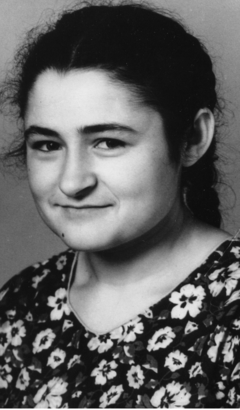Bella Subbotovskaya facts for kids
Quick facts for kids
Bella Abramovna Subbotovskaya
|
|
|---|---|
| Белла Абрамовна Субботовская | |

Subbotovskaya in 1961
|
|
| Born | December 17, 1937 |
| Died | November 23, 1982 (aged 44) |
| Cause of death | Car crash (suspected assassination) |
| Resting place | Vostryakovo Jewish Cemetery, Moscow |
| Nationality | Russian |
| Alma mater | Faculty of Mechanics and Mathematics, Moscow State University |
| Known for | Boolean formula complexity Jewish People's University |
| Spouse(s) |
Ilya Muchnik
(m. 1961–1971) |
| Scientific career | |
| Fields | Mathematical logic Mathematics education |
| Thesis | "A criterion for the comparability of bases for the realisation of Boolean functions by formulas" (1963) |
| Academic advisors | Oleg Lupanov |
Bella Abramovna Subbotovskaya (born December 17, 1937 – died September 23, 1982) was a smart mathematician from the Soviet Union. She started a special school called the Jewish People's University in Moscow. This school, open from 1978 to 1983, offered free lessons.
Its main goal was to help people who faced unfair treatment in the Soviet education system. This was especially true for Jewish students. The school was not approved by the government. Because of this, the KGB, which was the Soviet secret police, investigated it. Bella Subbotovskaya herself was questioned many times by the KGB. Sadly, she died shortly after being hit by a truck. Some people believe this was not an accident.
Contents
Bella's Work in Math
Before she started the university, Bella Subbotovskaya wrote important papers. These papers were about mathematical logic. Her ideas on how to write Boolean functions were very important. They helped a new field called computational complexity theory grow. This field studies how hard it is for computers to solve problems.
What are Boolean Functions?
Boolean functions are like simple rules that use "true" or "false" values. They are used in computer science and logic. Imagine a light switch: it's either ON (true) or OFF (false). Boolean functions combine these simple "on/off" ideas. They use operations like "AND" (both must be true), "OR" (at least one must be true), and "NOT" (changes true to false, or false to true).
The Method of Random Restrictions
Bella Subbotovskaya came up with a clever method called "random restrictions." Imagine you have a very complex puzzle with many pieces. This method helps you simplify the puzzle.
She would take a Boolean function, which is like a big math puzzle. Then, she would randomly pick some parts of the puzzle and give them a fixed answer (like "true" or "false"). This would make the puzzle much smaller and easier to solve.
For example, if you have a function with 10 variables (like 10 puzzle pieces), she might fix 7 of them. Then, you would only have 3 variables left to figure out. This makes the problem much simpler.
How Restrictions Help
Bella showed that using these random restrictions could make complex math problems much smaller. She proved that if you apply a random restriction, the size of the simplified problem becomes much, much smaller than the original.
This was a big deal because it helped mathematicians understand how complex some problems really are. It gave them a way to estimate the smallest possible way to solve certain problems.
Bella's Impact on Math
Even though her specific math proof was quite technical, her idea of "random restrictions" became a very important tool. Many other mathematicians have used and built upon her method.
Her work helped other researchers, like Paterson, Zwick, and Håstad, make even bigger discoveries. They used her ideas to prove how difficult certain problems are for computers to solve. Her methods are still used today in the field of computational complexity.
See also
 In Spanish: Bela Subbotovskaya para niños
In Spanish: Bela Subbotovskaya para niños

